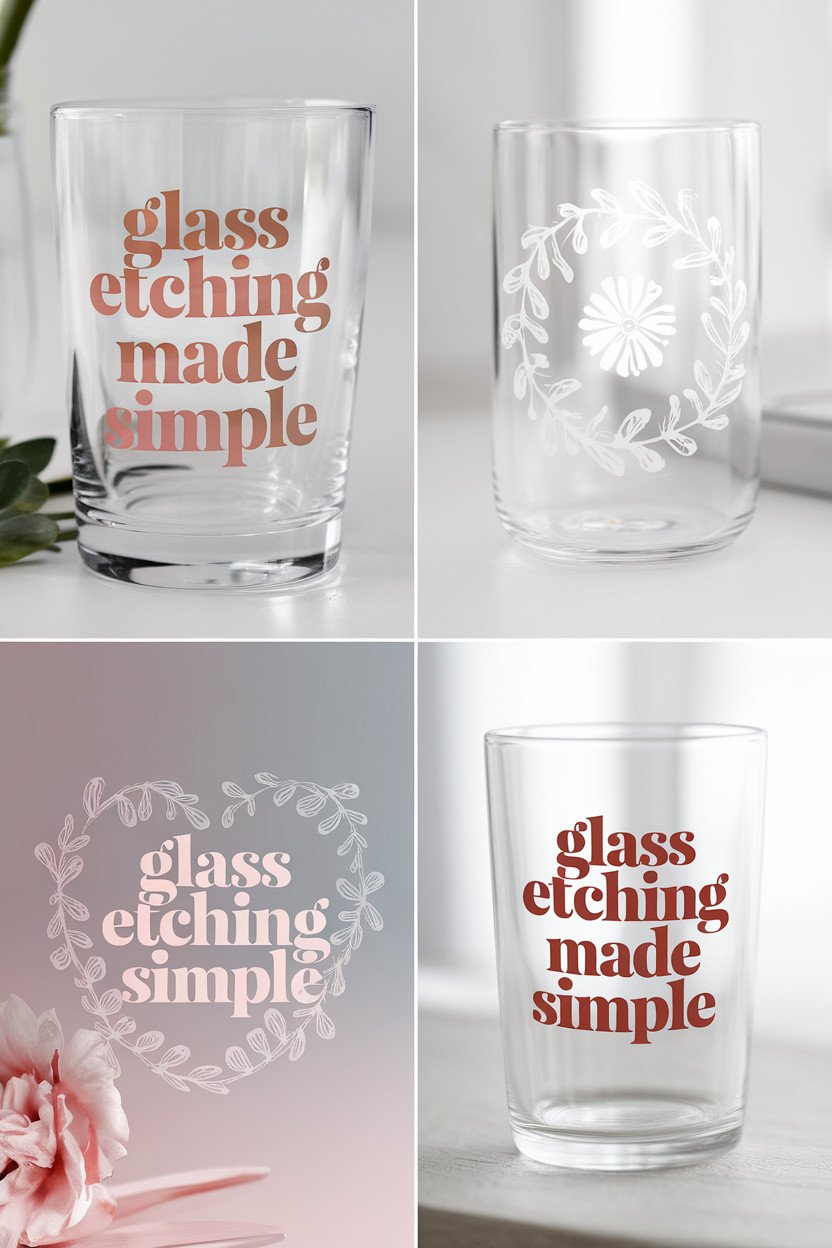Are you ready to unleash your creativity and create stunning etched glass artwork at home? With this comprehensive glass etching guide, you’ll learn everything you need to know, from the basics to advanced techniques. Whether you want to personalize glassware for your home or create unique gifts for loved ones, this DIY glass etching tutorial will show you how, step-by-step.
- Learn how to create professional-looking etched glass designs at home.
- Discover the unique benefits of glass etching and how it compares to other techniques.
- Find out what supplies you’ll need to get started and how to prepare your glass surface for etching.
- Explore different etching methods and learn how to create your own custom stencils.
- Add finishing touches to your etched glass designs for a truly unique look.
Why Choose Glass Etching?
If you’re new to glass etching, welcome! Etching glass is a fun and rewarding hobby that allows you to create beautiful and unique designs on any glass surface. From simple patterns to intricate designs, the possibilities are endless. Here are some reasons why you should choose glass etching:
- It’s a beginner-friendly craft that doesn’t require much experience or skill.
- You can personalize any glass surface, making it perfect for creating gifts or home decor.
- Glass etching is a versatile technique that can be used on a wide range of glass items.
But before you dive in, there are a few things to know to ensure your glass etching journey is a successful one. In the next sections, we’ll share some useful tips and tricks to help you get started and make the most out of your glass etching experience.

Before you begin your DIY glass etching project, ensure you have all the necessary supplies. Here is a comprehensive list of glass etching tools and materials to get you started:
- Glass surface to etch – this could be a glass jar, vase, mirror, or any other glass object
- Glass etching cream – some popular brands include Armour Etch and Etchall
- Stencil material – you can use vinyl, contact paper, or pre-cut stencils
- Exacto knife or craft cutter for cutting stencils
- Masking tape for securing the stencil to the glass surface
- Disposable gloves to protect your hands from the etching cream
- Protective eyewear to protect your eyes from the etching cream
- A brush or sponge to apply the etching cream
- A stopwatch or timer to track the etching time
- Sink or basin for rinsing off the etching cream
- Paper towels for cleaning and drying the glass surface
Many of these supplies can be found at your local craft store or online. Have fun shopping for your glass etching supplies and get creative!
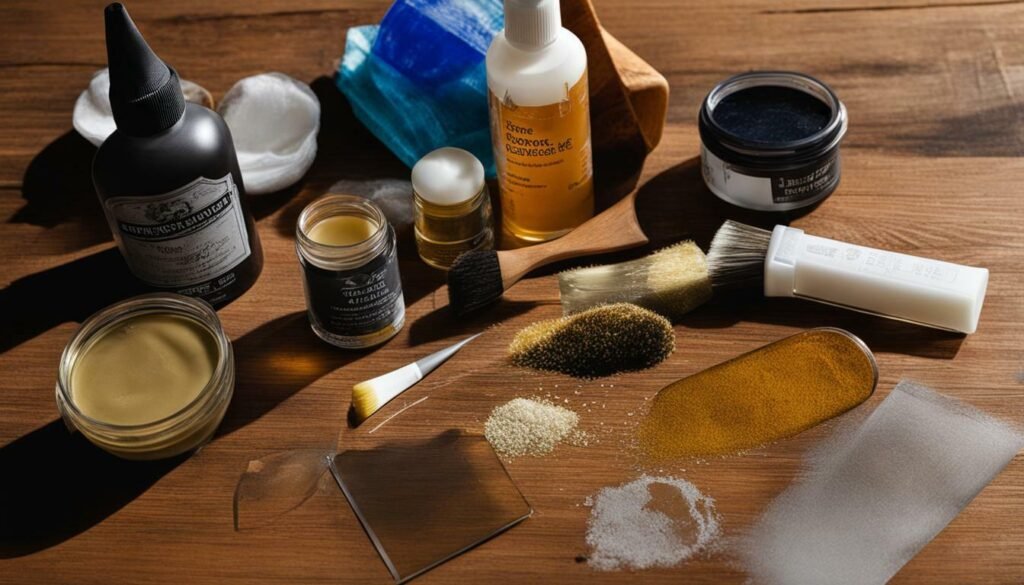
The first step to achieving professional-looking results in your glass etching project is to properly prepare your glass surface. Follow these step-by-step glass etching instructions to clean and prep your glass before etching:
- Choose the right glass: The best types of glass for etching are clear, smooth, and non-porous. Avoid any glass with textured surfaces or coatings.
- Clean the glass: Use a glass cleaner or rubbing alcohol to remove any dirt, dust, or fingerprints from the surface. Make sure the glass is completely dry before moving on to the next step.
- Apply masking tape: Use masking tape to cover any areas you don’t want to etch. This will ensure precise and clean etching lines.
- Remove any residues: Use a lint-free cloth and a small amount of rubbing alcohol or acetone to remove any oils or residues from the glass surface. This will help the etching cream adhere evenly to the glass.

By properly preparing your glass surface, you can ensure that your etched design will be even and precise. This step is crucial for achieving professional-looking results.
Choosing the Right Etching Method
Before diving into your glass etching project, it’s essential to decide which method you want to use to achieve your desired design. Here are some popular glass etching techniques:
- Etching Cream: A popular method, etching cream is easy to use and doesn’t require any special equipment. Simply apply the cream to your stencil and wait for it to etch the glass.
- Sandblasting: Sandblasting uses high pressure to shoot abrasive material at the glass surface, creating a frosted effect. This method requires specialized equipment.
- Engraving: Engraving uses a tool to carve the design into the glass. This is a time-consuming method but can produce intricate and detailed designs.
When deciding on the right method for your project, consider factors such as design complexity, time, and budget. Each method has its own benefits and drawbacks – experiment to find the one that works best for you!
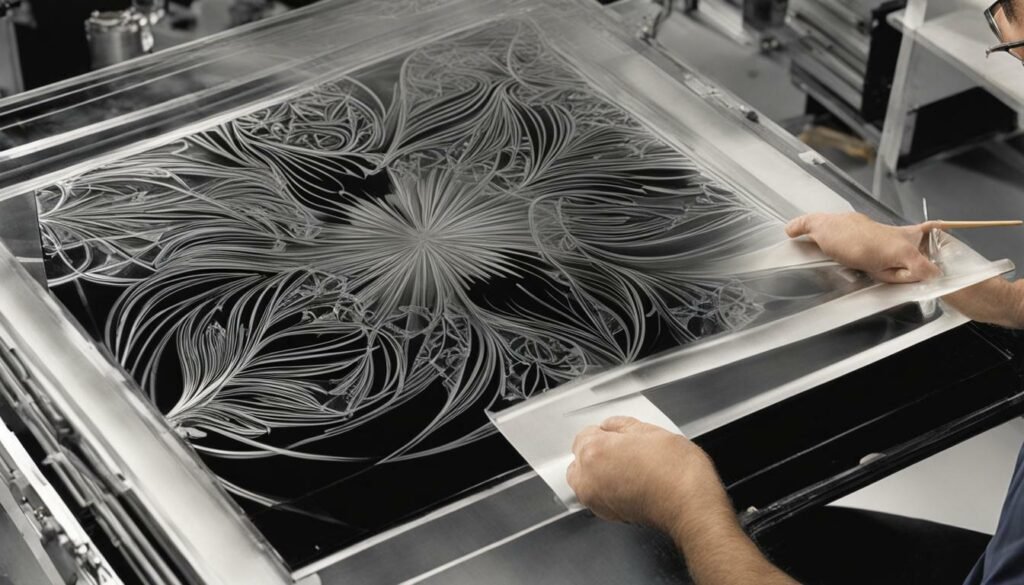
Creating custom stencils is a great way to add a personalized touch to your glass etching projects. Follow these steps to create your own:
- Choose a design: Think about the design you want to etch onto your glass surface. Simple designs work best for beginners.
- Print and cut your design: Print your design onto vinyl or stencil paper. Use a craft knife or scissors to cut out the areas where you want the etching cream to go.
- Apply the stencil: Remove the backing from the stencil and apply it to the glass surface. Make sure it is smooth and there are no air bubbles.
- Secure the stencil: Secure the stencil in place with masking tape or painter’s tape to prevent etching cream from seeping under the stencil.

With your custom stencil in place, you can now apply the etching cream following the steps in Section 7. Remember, the key to successful glass etching is to take your time and follow instructions carefully.
Applying the Etching Cream
Now that you have prepped your glass surface and designed your stencil, it’s time to apply the etching cream. Follow these step-by-step instructions to ensure precise and even coverage:
- Put on protective gloves to avoid getting the etching cream on your skin.
- Apply a thick layer of the etching cream over the stencil, covering the entire design.
- Use a squeegee or a flat edge to spread the cream evenly over the stencil.
- The etching cream should be left on for the recommended amount of time based on the instructions provided with the cream.
- When the time is up, rinse the glass thoroughly with water to remove all the cream.
- Peel off the stencil and remove any residue with a glass cleaner.
For different etching effects, leave the cream on for longer or shorter periods. For example, if you want a light frost, leave the cream on for a shorter time, and if you want a deep etch, leave the cream on for longer.
Remember to always read the instructions on the etching cream carefully and follow the safety precautions. And that’s it- you have successfully etched your glass surface!

After applying the etching cream, it’s important to wait for the recommended amount of time before rinsing off the cream to reveal your etched design. The time may vary depending on the type of etching cream you use, so make sure to follow the instructions carefully.
If you’re unsure of whether the etching is complete, gently scrape the cream off with a spatula. If the lines of your design are visible, it’s ready for rinsing. Rinse the glass under running water, removing all traces of the etching cream. Make sure not to touch the etched surface with your fingers, as this could cause damage or smudging.
- Some tips for rinsing off the etching cream include:
- Use gloves to protect your hands
- Use lukewarm water for better results
- Rinse the glass thoroughly to ensure all the cream has been removed
Once your glass is rinsed, it’s time to reveal your etched design. Carefully dry the glass with a towel, and your etched design will be ready to admire!

Adding finishing touches to your glass etching projects can take them to the next level. Here are a few ideas:
- Enhance the etched areas with glass paint or markers, creating a stained glass effect.
- Add rhinestones or other small embellishments to the design for extra sparkle.
- Use a glass cutter tool to add texture to the surface by creating small grooves or lines.
- Combine etching with other glass techniques, such as fusing or molding, to create layered or sculptural designs.
Get creative and experiment with different materials and techniques to make your glass etching projects truly unique!

Now that you’ve created your beautiful etched glass artwork, it’s essential to take care of it properly to ensure it lasts for years to come. Here are some tips to maintain your etched glass:
- Always handle your etched glass with clean hands to prevent fingerprints and oil residue.
- Wash your etched glass using mild dish soap and warm water, avoiding harsh scrubbers or abrasive cleaners that can scratch the surface.
- Never soak your etched glass in water or put it in a dishwasher, as it can damage the artwork.
- Dry your etched glass using a lint-free cloth or paper towel to prevent water spots and streaks.
- Avoid exposing your etched glass to extreme temperatures or sudden changes in temperature, such as placing it in the fridge or oven.
By following these simple guidelines, you can ensure your etched glass stays looking as beautiful as the day you created it.
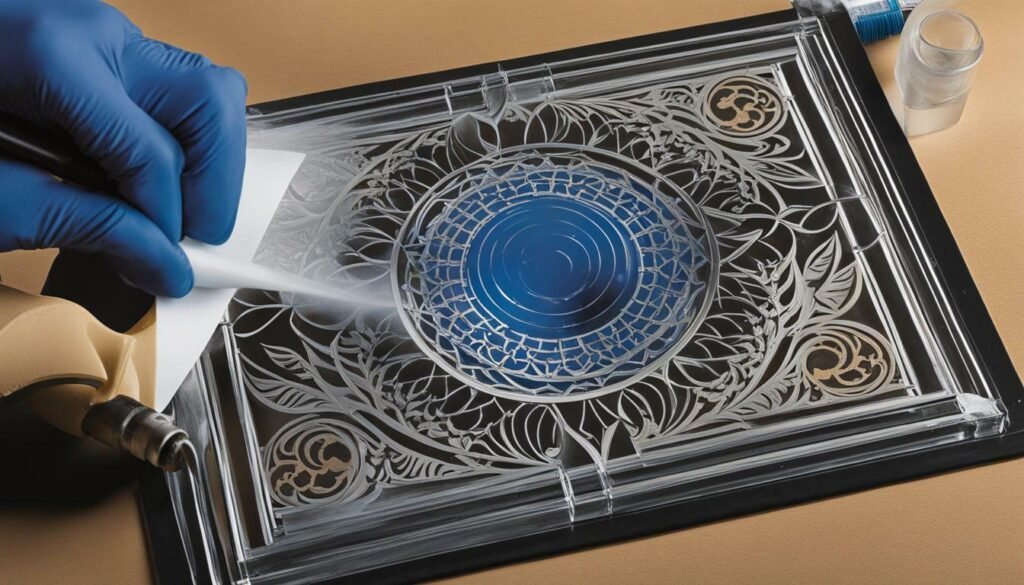
While glass etching is a fun and creative activity, sometimes issues can arise during the process. Don’t worry, as many common problems can be easily resolved. Here are some of the most encountered issues and how to fix them:
- If the etching cream isn’t covering the surface evenly, try using a brush to spread it.
- If the etching doesn’t appear to be deep enough, leave the cream on for a few extra minutes.
- If the stencil isn’t sticking to the glass surface, try cleaning the surface again or using a different adhesive.
- If you accidentally etch the wrong area, try using fine-grit sandpaper to remove the etching cream and start over.
Remember to always follow safety precautions, including wearing gloves and working in a well-ventilated area. With a little patience and practice, you’ll be able to troubleshoot and overcome any issues you encounter during the glass etching process.
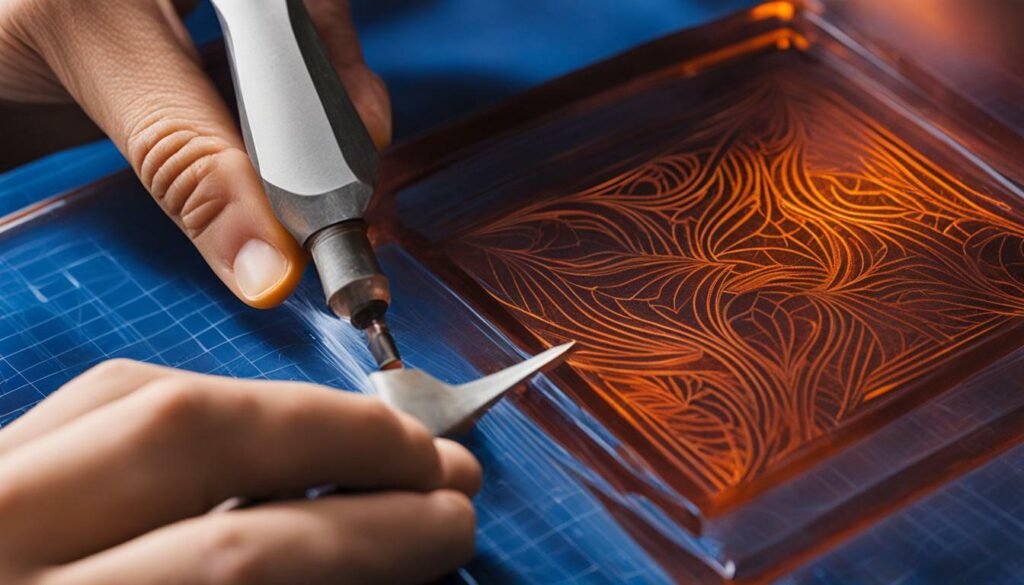
Exploring Advanced Glass Etching Techniques
Now that you’ve mastered the basics of glass etching, it’s time to take your skills to the next level with advanced techniques. Here are some ideas to explore:
- Create multi-layered designs by etching different areas of the glass at different times.
- Experiment with textures by using different abrasive materials, such as sandpaper or a Dremel tool.
- Add color to your etched designs using glass paints or markers.
- Combine etching with other techniques, such as painting or decoupage, for unique mixed-media creations.
Remember, the possibilities are endless when it comes to glass etching. Let your imagination run wild and push your creativity to new heights with these advanced techniques.

Get inspired by checking out our next section for more creative glass etching ideas!
Inspiring Glass Etching Ideas
Ready to get creative with glass etching? Here are some inspiring ideas to get you started:
- Personalized glassware: Add a special touch to glassware by etching names, initials, or meaningful words. Great for weddings, anniversary gifts, or special occasions.
- Decorative vases: Etch intricate patterns or designs onto glass vases to add a unique touch to your home decor.
- Customized mirrors: Give your mirrors a new lease of life by etching designs onto the glass surface. Perfect for statement pieces.
- Stained glass effect: Create a stunning stained glass effect by etching intricate designs onto a large glass surface. Hang in a window for a beautiful display.
- Etched photo frames: Personalize photo frames by etching names or quotes onto glass. Great for gifting to loved ones.
- Customized glass doors: Add privacy or style to glass doors by etching patterns or designs onto the surface.

With these ideas, the possibilities for glass etching are endless. Let your creativity flow and see what beautiful designs you can create with your DIY glass etching skills.
Share Your Glass Etching Creations
Congratulations on completing your glass etching project! Now it’s time to share your masterpiece with the world. Here are a few ways to showcase your work and inspire others:
- Post pictures of your glass etching creations on social media, using hashtags like #DIYGlassEtching or #GlassEtchingIdeas to reach a wider audience.
- Create a blog or website to document your glass etching journey and share tutorials, tips, and tricks with others.
- Enter your glass etching projects in local or online craft contests to gain recognition and maybe even win prizes.
- Donate your glass etching creations as gifts to family and friends, or sell them at craft fairs or online marketplaces like Etsy.
The possibilities are endless, so don’t be afraid to share your creativity with the world. Who knows – your glass etching project may inspire others to start their own DIY glass etching journey!
FAQ
What is glass etching?
Glass etching is a technique that involves creating designs or patterns on the surface of glass using etching creams, sandblasting, or engraving tools. It creates a frosted or matte appearance on the glass, adding a decorative element to various glass objects.
Can I etch any type of glass?
Glass etching can be done on a wide range of glass surfaces, including windows, mirrors, glassware, and more. However, it’s important to note that some types of glass, such as tempered or safety glass, may be more difficult to etch due to their durability and resistance to etching products. It’s best to test a small area before etching the entire surface.
Is glass etching safe?
When following proper safety precautions, glass etching is generally safe. It’s important to work in a well-ventilated area and use protective gear, such as gloves and goggles, to prevent contact with etching products. Always read and follow the instructions on the etching creams or chemicals you are using and keep them out of reach of children and pets.
How long does glass etching take?
The time it takes to complete a glass etching project can vary depending on the complexity of the design and the etching method used. Simple designs can be etched in as little as 10-15 minutes, while more intricate patterns may require several hours or even multiple sessions. It’s important to follow the recommended time for applying the etching cream and rinsing it off to achieve the desired results.
Can I remove or fix mistakes in glass etching?
Unfortunately, once the glass etching process is complete, it can be challenging to remove or fix any mistakes. It’s important to take your time and double-check your design before applying the etching cream. If you make a mistake, you may need to start over with a new piece of glass or find creative ways to incorporate or cover up the error.
Can I etch colored or painted glass?
Etching colored or painted glass can be challenging because the etching cream may not adhere well to the surface. It’s best to work with clear glass for optimal results. If you want to etch colored glass, consider using a stencil or masking tape to protect the areas you don’t want to etch, and then carefully apply the etching cream to the desired areas.
How do I clean and care for etched glass?
To clean etched glass, use a gentle glass cleaner or a mixture of mild soap and water. Avoid using abrasive materials or harsh chemicals that could damage the etched surface. When drying, use a soft, lint-free cloth to prevent scratching. Additionally, it’s important to handle etched glass with care and avoid placing heavy objects on it to prevent any potential damage.
Can I eat or drink from etched glassware?
While glass etching is generally safe, it’s not recommended to consume food or beverages directly from etched glassware. The etching process may create microscopic grooves or rough surfaces on the glass, which could harbor bacteria or affect the taste of the food or drink. It’s best to use etched glassware for decorative purposes or serve food and drinks in separate, non-etched containers.
Where can I find glass etching supplies?
Glass etching supplies can be found at craft stores, online retailers, and specialized glass etching suppliers. Look for etching creams, stencils, glass etching tools, and protective equipment to get started. It’s important to read reviews and choose high-quality products for the best results in your glass etching projects.
